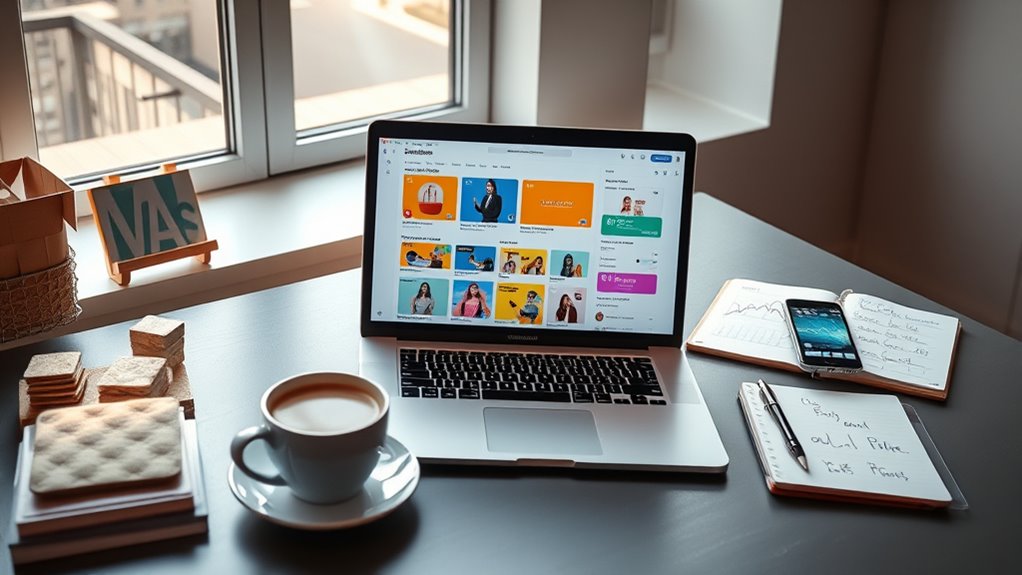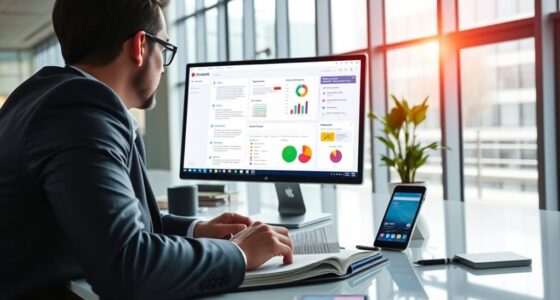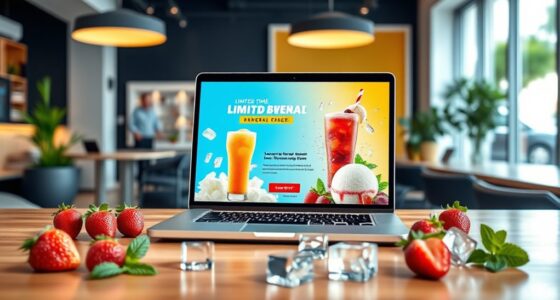To convert browsers into buyers, focus on understanding your audience through detailed segmentation based on preferences, behaviors, and purchase history. Personalize your email content with dynamic recommendations and compelling visuals, and send messages at ideal times with the right frequency to boost open rates. Use incentives like discounts to create urgency, analyze campaign metrics to refine strategies, and follow up to build loyalty. Keep exploring these tactics to reveal even more effective ways to turn casual visitors into loyal customers.
Key Takeaways
- Segment your email list based on customer data to deliver personalized, relevant content that resonates with individual preferences.
- Use engaging, visually appealing emails with personalized product recommendations and tailored messaging to increase customer interest.
- Optimize sending times and frequency to boost open rates, using follow-ups to deepen engagement and nurture relationships.
- Incorporate incentives like discounts and limited-time offers to create urgency and motivate quick conversions.
- Monitor key metrics such as open rates, click-throughs, and conversions to refine strategies and build long-term customer loyalty.
Understanding Your Audience and Segmenting Effectively
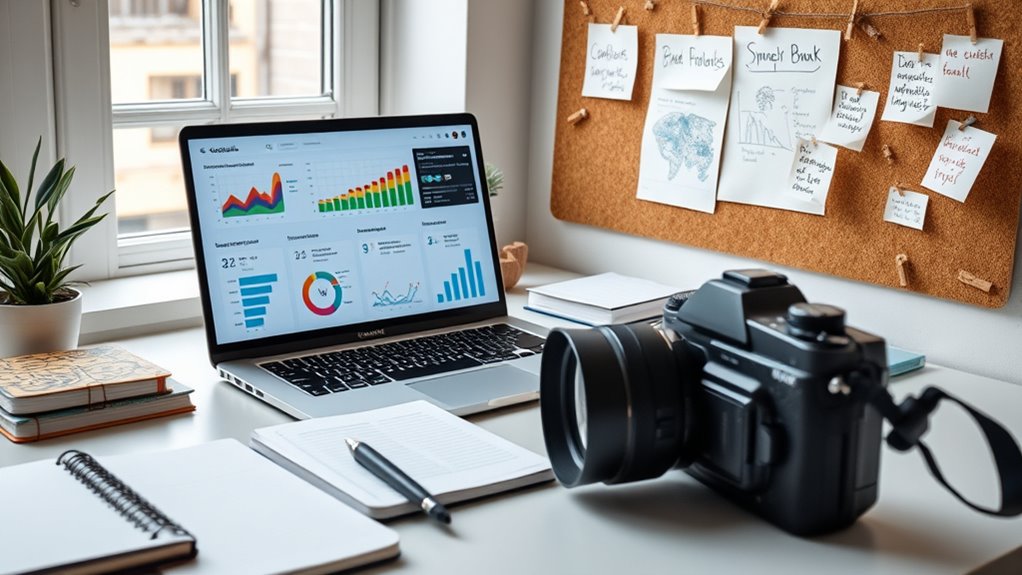
Have you truly understood who your customers are? Knowing your audience starts with creating detailed customer personas—profiles that highlight their preferences, behaviors, and needs. These personas help you tailor your messaging effectively. Data segmentation is key; it allows you to divide your email list based on demographics, purchase history, or engagement levels. By segmenting your data, you can send targeted, relevant content that resonates with each group. This targeted approach ensures that your campaigns are more personalized and effective. Don’t treat your entire audience the same—use insights from customer personas and data segmentation to craft personalized campaigns. Understanding your audience at this level guarantees your emails speak directly to their interests, making your marketing efforts more efficient and impactful.
Crafting Engaging and Personalized Email Content

To capture your audience’s attention, you need to use personalization strategies that truly resonate. Crafting compelling email copy means speaking directly to their interests and needs. When you focus on these key points, your emails become more engaging and effective. Incorporating sound design principles can help you create more immersive and memorable messaging that stands out.
Personalization Strategies That Work
Personalization is essential for capturing your audience’s attention and driving engagement in your emails. To do this effectively, leverage dynamic content that adapts based on each recipient’s behavior and preferences. Predictive analytics help you anticipate what your customers want, enabling you to send relevant offers and recommendations. Envision this: a personalized email showcasing products tailored to a shopper’s browsing history, with images, descriptions, and discounts all customized in real-time. Here’s a visual of how personalized content can appear:
| Customer Segment | Recommended Products | Special Offers |
|---|---|---|
| New visitors | Trending items | Welcome discount |
| Loyal buyers | Upsell options | Exclusive deals |
| Abandoned cart | Reminder products | Free shipping |
| Price-sensitive | Budget-friendly picks | Limited-time offer |
| Past buyers | Complementary items | Loyalty rewards |
This approach boosts engagement and conversions. Additionally, understanding customer preferences allows you to craft more authentic and compelling email campaigns that resonate with your audience.
Writing Compelling Email Copy
Curious about how to make your emails stand out in crowded inboxes? The key is crafting compelling email copy that reflects your brand voice and engages your audience. Use clear, concise language that speaks directly to your customers’ needs and desires. Personalization isn’t just about adding names; tailor your message to their preferences and past behaviors. Incorporate a strong call-to-action that motivates recipients to act. Additionally, your email design should complement your copy, making it easy to read and visually appealing. Use headings, bullet points, and images strategically to break up text and highlight key messages. Remember, engaging and personalized content combined with thoughtful email design creates a seamless experience that turns browsers into buyers. Understanding your audience’s skin type can help you craft more targeted and effective messaging.
Timing and Frequency: When and How Often to Reach Your Customers

Choosing the right times to send emails can considerably boost your open rates, so consider when your customers are most likely to check their inboxes. You also need to find a balance in how often you reach out, so you stay top of mind without overwhelming them. Let’s explore how to optimize both timing and frequency for maximum engagement. Incorporating insights about email deliverability can help ensure your messages are actually seen and opened.
Optimal Sending Times
Timing is essential when it comes to maximizing your email engagement. Sending your emails at the right time increases open rates and boosts conversions. Consider your audience’s habits—are they more likely to check emails in the morning or evening? Mid-week mornings often perform well, but testing your specific audience is key. Your subject line should be clear and compelling, catching attention quickly. Equally important is your email design; keep it simple and mobile-friendly, so recipients can easily read and act on your message. Avoid sending too frequently, as it can lead to fatigue and unsubscribes. Instead, space your emails to arrive when your audience is most receptive, balancing consistency with relevance for ideal results. Monitoring your engagement metrics can help determine the best sending times for your campaign.
Balancing Email Frequency
Finding the right balance in email frequency is essential to maintaining your audience’s engagement without overwhelming them. Sending too many emails can lead to email fatigue, causing customers to ignore or unsubscribe. Conversely, infrequent messages risk inbox saturation, making your brand forgettable. To strike this balance, monitor engagement metrics like open and click-through rates, adjusting your send frequency accordingly. Consider segmenting your audience based on their preferences and behaviors, tailoring your outreach to their comfort level. Consistent but not excessive communication builds trust and keeps your brand top of mind. Remember, quality content matters more than quantity—fewer well-timed emails can drive better conversions than frequent, poorly targeted messages. Track development is crucial for optimizing your email strategy over time, helping you find that sweet spot where you stay relevant without overwhelming your customers.
Leveraging Incentives to Drive Conversions
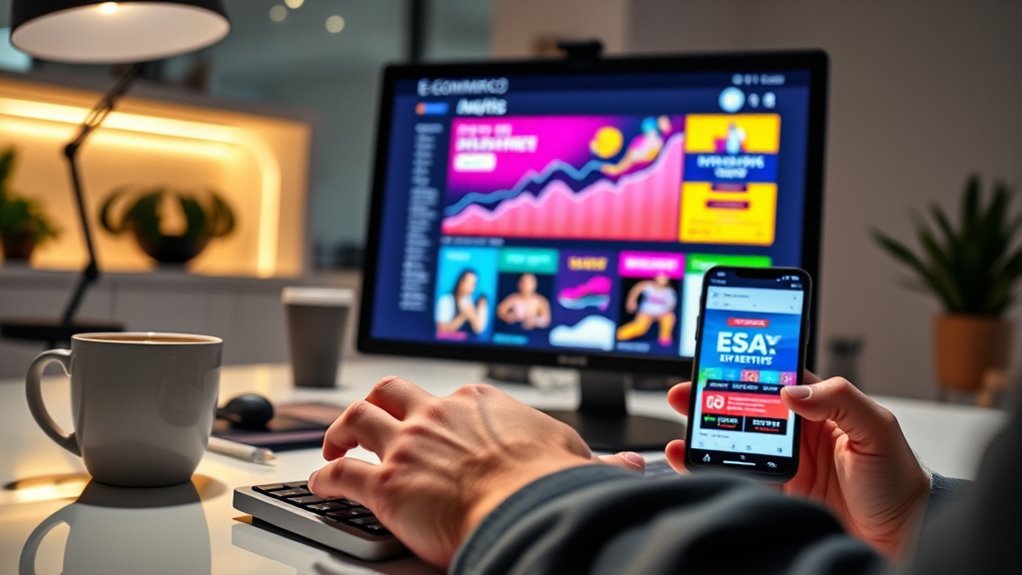
Have you ever wondered why some email campaigns see higher conversion rates than others? The key often lies in leveraging incentives effectively. Using discount codes and limited time offers creates urgency and value that prompt action. For example, imagine a table illustrating different incentives:
| Incentive Type | Example | Urgency Level |
|---|---|---|
| Discount Codes | 20% off your next purchase | Moderate |
| Limited Time Offers | 24-hour flash sale | High |
| Free Shipping | On orders over $50 | Moderate |
| Exclusive Access | Early access to new products | High |
Analyzing Metrics and Optimizing Campaign Performance
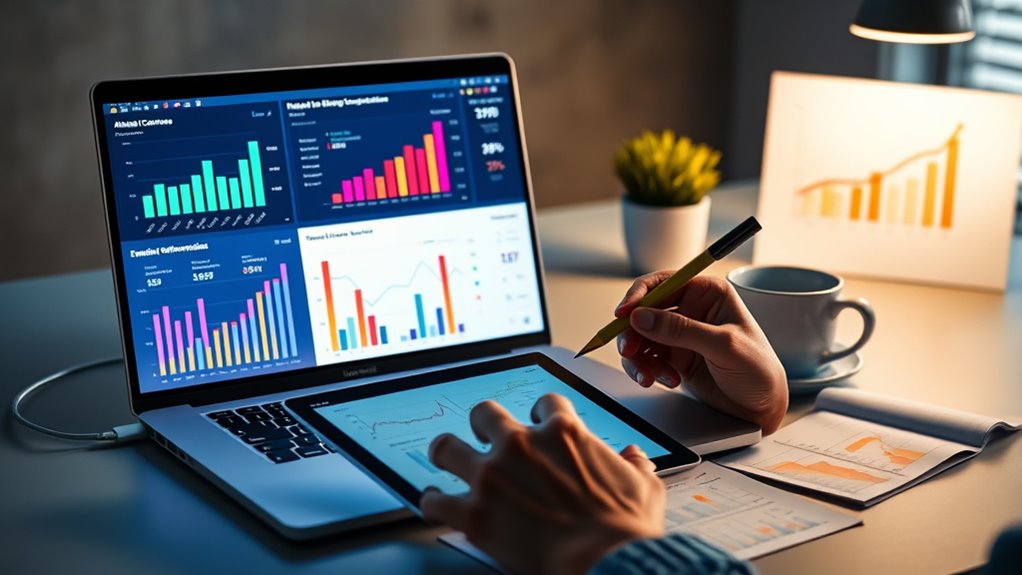
To maximize your email campaign’s effectiveness, it’s essential to analyze key performance metrics systematically. Start by reviewing your deliverability rates to guarantee your emails reach inboxes and aren’t flagged as spam. Monitoring open and click-through rates helps you gauge engagement and identify what resonates with your audience. Use A/B testing to compare different subject lines, content, and calls-to-action, revealing what drives better results. Pay attention to bounce rates and unsubscribe data to spot issues early. Additionally, understanding Gold IRA Rollovers can help tailor content for audiences interested in diversifying their retirement portfolios. Continuously refine your strategies based on these insights, making data-driven adjustments to improve overall performance. Regularly analyzing these metrics allows you to optimize campaigns, increase conversions, and build stronger customer relationships over time.
Building Customer Loyalty Through Follow-Up Strategies
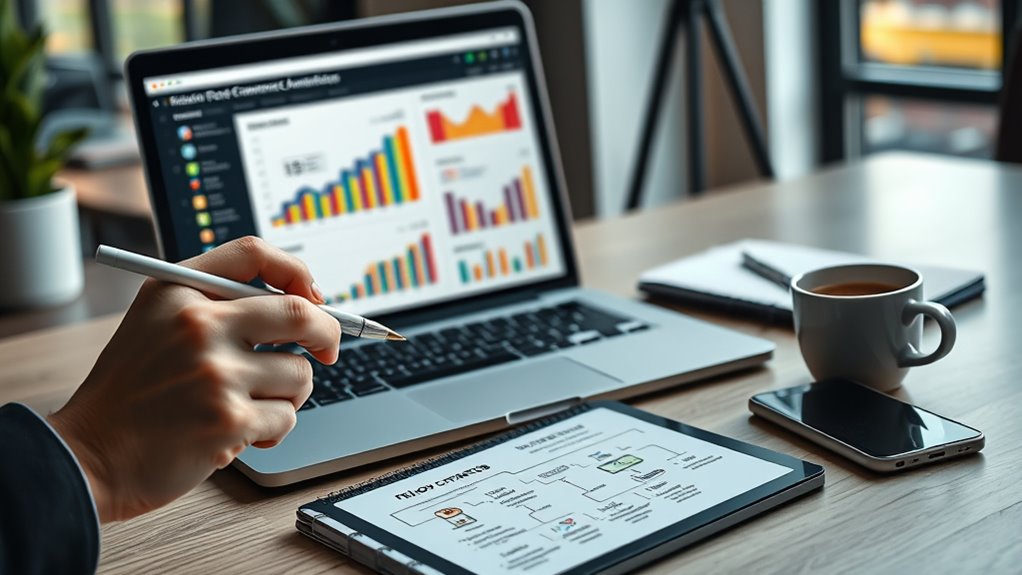
After analyzing your email metrics and identifying areas for improvement, the next step is to focus on building lasting customer loyalty through effective follow-up strategies. You can enhance customer engagement by sending personalized follow-up emails that thank customers for their purchase or ask for feedback. Incorporate loyalty programs into your follow-up to reward repeat business and reinforce brand connection. Consider offering exclusive discounts or early access to new products as incentives. Regularly engaging customers after their initial purchase keeps your brand top of mind and encourages repeat business. Use data from your follow-ups to refine your approach, ensuring your messages resonate and foster long-term loyalty. Additionally, understanding electric dirt bike performance can help you tailor your messaging to customers interested in high-performance products. Consistent, thoughtful follow-up transforms casual buyers into dedicated brand advocates.
Frequently Asked Questions
How Can I Prevent My Emails From Ending up in Spam Folders?
To prevent your emails from ending up in spam filters, you need to focus on email authentication methods like SPF, DKIM, and DMARC. These help verify your identity and build trust with spam filters. Avoid using spammy language and excessive capitalization, and always send relevant, personalized content. Regularly monitor your sender reputation and engagement rates, so your emails reach your audience’s inbox instead of the spam folder.
What Are the Best Practices for Mobile Optimization in Email Campaigns?
To optimize your email campaigns for mobile, focus on responsive design that adjusts seamlessly to various screen sizes. Use a thumb-friendly layout with large, easy-to-tap buttons and clear, concise text. Keep images optimized for quick loading, and test your emails across devices to guarantee they look great everywhere. By making your emails mobile-friendly, you’ll enhance user experience and boost engagement, increasing the chances of converting browsers into buyers.
How Do I Handle Unsubscribes Without Losing Potential Customers?
You should develop unsubscribe strategies that prioritize customer retention. When someone opts out, offer a simple way to adjust preferences instead of complete removal, keeping them engaged at a different level. Personalize your approach by asking for feedback, showing appreciation, and providing exclusive content or discounts. This way, you maintain a relationship, potentially turning unsubscribers into loyal customers, and protect your brand reputation by respecting their choices.
What Legal Regulations Should I Consider in Email Marketing?
When you’re working with email marketing, you should carefully consider compliance and confidentiality. Focus on consent requirements, ensuring you have clear permission before sending emails. Prioritize data protection by safeguarding subscriber information and respecting privacy laws. Stay updated on regulations like GDPR or CAN-SPAM, and always provide easy options for recipients to opt-out. By aligning your practices with these legal requirements, you protect your business and build trust with your customers.
How Can I Personalize Emails Without Infringing on Customer Privacy?
To personalize emails without infringing on customer privacy, you should focus on using customer data responsibly. Implement transparent data collection practices and ask for consent. Use personalization strategies that rely on aggregate or anonymized data rather than detailed personal info. This way, you can tailor content effectively while respecting privacy, building trust, and complying with regulations. Always give customers control over their data and preferences to foster loyalty.
Conclusion
By applying these strategies, you’ll turn browsers into loyal buyers. Did you know that personalized emails generate 6 times higher transaction rates? Focus on segmenting your audience, crafting compelling content, and timing your messages right. Keep analyzing your metrics to refine your approach. With consistent follow-up and incentives, you’ll boost conversions and build lasting customer loyalty—making every email count in your e‑commerce success story.
